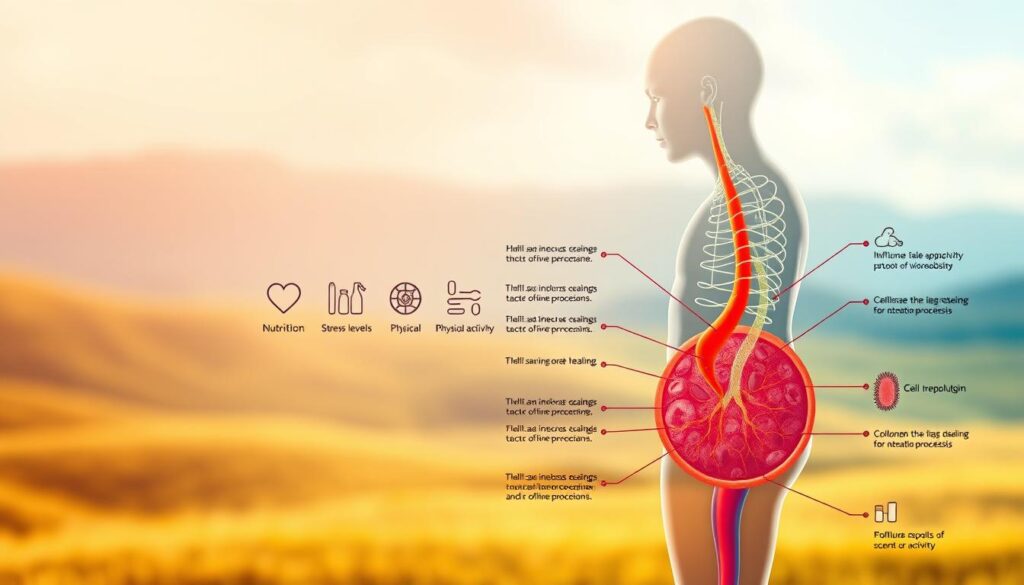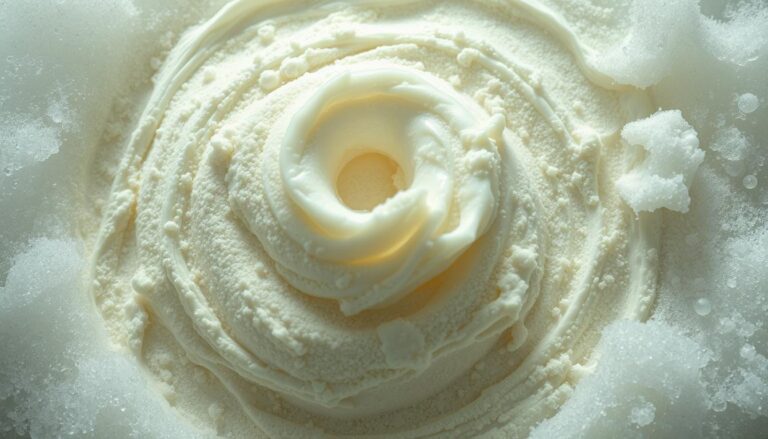How Long is the Healing Process?

Millions of people around the world get medical procedures or get injured every year. This begins their body’s amazing healing journey. Many wonder about the healing process timeline. It’s a series of complex biological steps. These steps don’t work the same for everyone. While healing often takes four to six weeks, it can change based on the injury and the person’s health.
The nitty-gritty of the healing time frame is not just about wound closing. It involves a complex dance of cells and proteins, all working to fix the damage. Acute wounds typically heal in a set path. But chronic wounds can stray off this path. Things like infections or other health issues can slow down healing.
Key Takeaways
- The healing process timeline is complex and individualized, often influenced by the nature of the injury and the patient’s overall health.
- Recovery duration could extend beyond the typical four to six-week period, particularly in the presence of complicating factors.
- A clear understanding of the healing time frame is vital to managing expectations and optimizing recovery strategies.
- Acute wounds typically undergo a four-phase healing trajectory, while chronic conditions may encounter hurdles that alter this course.
- Patients and healthcare providers should consider the interplay of biological events and personal circumstances in each healing process.
Introduction to the Healing Process
It’s important for both doctors and patients to understand the healing process. Knowing how long healing takes allows for realistic recovery goals. It also helps create the best conditions for healing.

The Importance of Understanding Healing Timelines
Understanding how long healing takes helps manage expectations. It’s key in planning treatments. In settings where resources and timing are crucial, this knowledge helps improve results.
Different Types of Healing
There are two main kinds of healing: acute and chronic. Acute healing is fast and follows a clear path. Chronic healing takes longer and can be blocked by various factors.
Factors Influencing Healing Duration
Many things can affect how well and quickly a wound heals. These include:
- Age: Younger people heal faster than older ones.
- Nutrition: Good nutrition is crucial for cell growth and immune health.
- Comorbidities: Diseases like diabetes and obesity can slow healing.
- Lifestyle Choices: Smoking and drinking can harm wound healing.
Understanding these factors helps tailor healing plans. It can make recovery faster and more effective.
Physical Healing: A Closer Look
Health practitioners and patients must understand physical healing. This includes how long common injuries heal, post-surgery recovery, and the role of nutrition. These factors are key for a smooth recovery.
Common Injuries and Their Healing Times
Each physical injury, like minor cuts or severe fractures, has its own healing time. Simple fractures might heal in six weeks. But, complex injuries could take months. The healing time depends on the injury and the person’s health.
Post-Surgical Recovery: What to Expect
The healing from surgery varies greatly. After surgery, the body’s tissue begins to repair and close the wound. Knowing about this helps patients and doctors better manage recovery.
The Role of Nutrition in Healing
Good nutrition is crucial for healing after an injury or surgery. Eating enough proteins, vitamins, and minerals helps the body heal faster. Zinc and iron are particularly important for tissue repair.
Proper nutrition can greatly improve how fast and how well a body heals after surgery.
Understanding physical healing helps patients improve their recovery. This knowledge is also useful for healthcare professionals. It lets them provide care that helps patients heal better and faster.
Mental Health Healing Process
Mental healing is like going through a complex maze. It involves both emotional and psychological recovery. Like healing a physical injury, the mind also needs time and care. Everyone’s healing journey is different due to various factors.

Emotional healing duration can differ a lot from person to person. It depends on the mental health issue’s severity. Therapy is great for therapeutic impact on mental health. It speeds up healing by offering coping ways and emotional support.
To see how well recovery is going, we look at mental recovery indicators. These include better mood and emotions, stress management, and getting back to daily activities. Knowing these signs helps both doctors and patients understand how well therapy is working.
Here are signs that show mental health is getting better:
- Increased feelings of hope and positivity
- Improved sleep patterns and appetite
- Enhanced concentration and decision-making abilities
- Greater capacity for enjoying life and maintaining relationships
- Reduced symptoms of stress and anxiety
Mental health recovery takes patience, understanding, and a special therapy plan. It’s important to know that everyone heals differently. Acknowledging this and the therapeutic impact on mental health helps create a good recovery environment.
Healing Time for Chronic Conditions
Treating chronic conditions is complex due to the long time needed for healing. An integrated approach that includes healing chronic wounds, changing lifestyles, and focusing on the patient’s education is very important. This approach helps in managing the condition better and improving the patient’s health.
Chronic illnesses last a long time and often get worse. They require a well-rounded approach that combines medical care with daily actions. The process of healing chronic wounds takes continuous effort. Treatments must be adjusted to fit each patient’s unique needs.
- Lifestyle Modifications: Your daily choices have a big impact on managing chronic conditions. Changing your habits is not only about what you eat or how much you exercise. It also includes managing stress, sleeping well, and avoiding bad habits like smoking and drinking too much. Making these changes can greatly improve your health and help you heal faster.
- Patient-Centric Education: Knowing more about your health condition gives you power. Teaching patients about their illness, the need to follow their treatment plans, and how to handle symptoms helps them take charge of their recovery. Good education leads to more involvement and better results in managing chronic conditions.
It’s vital to understand and meet the needs of people with chronic illnesses. This means making specific lifestyle changes and giving thorough education that’s focused on the patient. Doing so not only helps with healing wounds but also improves their quality of life greatly.
| Aspect | Impact on Chronic Healing |
|---|---|
| Lifestyle Modifications | Significantly improves management of symptoms and overall health. |
| Patient-Centric Education | Increases patient engagement and compliance with treatment regimes. |
The Psychological Aspect of Healing
The journey of healing involves both the mind and body. Understanding the mind’s role is key to full recovery. We’ll look at how mental strength and coping methods help in healing.

Mental resilience is crucial for healing. It helps people deal with health challenges and encourages active participation in their recovery. By building mental resilience, individuals can turn their healing journey into a path of empowerment and growth.
Healing strategies vary from person to person. Mindfulness boosts focus and awareness, while positive self-talk changes harmful thoughts. Having supportive friends and family is also critical during recovery times.
These components create a strong recovery plan. Here’s their role:
- Mindfulness improves awareness and helps manage stress during healing.
- Positive self-talk builds mental strength, promoting a healing mindset.
- Social Support offers needed emotional and practical help, vital for overcoming obstacles in healing.
Integrating these psychological healing factors into daily routines helps with current and future health issues. Mental strength and good coping strategies form a healing process marked by power and elegance.
Age and Healing: How It Affects Recovery
Age plays a big role in how well we heal from injuries. At different stages of life, our bodies recover at different speeds. Knowing why can help us find better ways to treat injuries. As we grow from kids to older people, our body’s reaction to injury changes. This affects how fast and well we can heal.
Childhood injury healing is super quick. Kids have strong healing powers and their cells are very active. Their bodies can bounce back from trauma faster. This makes being a kid a great time for healing from injuries.
As we get older and become adults, healing takes a bit longer. Adults can still heal pretty well, but not as fast as children. The time it takes to recover can be longer and depends on our lifestyle, health, and how bad the injury is.
Older adults have the hardest time healing. Elderly wound recovery is slowed down by things like less stretchy skin, less collagen, and slower cell growth. Caring for older adults means being extra gentle and giving them more time to heal.
- Regenerative capacity decreases with age.
- Higher susceptibility to complications like infections in the elderly.
- Need for enhanced nutritional support and specialized care strategies.
In summary, how old you are affects how you heal. From making sure kids heal well, to helping adults recover at their own pace, to taking special care of older people. Knowing about these differences helps us give better care to everyone, no matter their age.
The Healing Process for Women
Understanding female health is key to addressing women’s specific healing needs. Women have unique biological systems. These systems require customized approaches, especially in phases like postpartum recovery.
Unique Health Issues Affecting Women
Women face health challenges like hormonal changes, endometriosis, and fibroids. These issues greatly affect their healing. It shows why healthcare for women needs to focus on their unique biological and physiological needs.
Pregnancy and Postpartum Healing
Postpartum recovery needs lots of care and understanding. It involves healing from childbirth and adjusting to hormonal changes. These changes impact women’s well-being.

From adolescence to later stages, female health requires deep understanding. This helps create targeted treatments and support. It addresses women’s specific health issues effectively.
- Early Diagnosis: Spotting symptoms early can help tackle issues like PCOS and endometriosis. Detected early, these conditions won’t heavily impact a woman’s health and recovery times.
- Specialized Care Plans: Customized care plans for postpartum recovery ensure women get the right nutrients and medical care. This leads to a healthier recovery.
- Ongoing Support: Continuous support is important, especially for mental health after childbirth. It’s a key part of postpartum recovery.
Vigilance and specialized knowledge improve health strategies for women’s healing needs. This enhances the success of postpartum recovery and overall female health.
The Role of Healthcare Professionals
The skills of healthcare workers play a big part in healing. They guide us when getting medical help is necessary for a quick and safe recovery. These experts give immediate care and have a big say in the success of treatments.
For top-notch professional wound management, when and how medical help is given matters a lot. An early check-up can decide the path to healing. It’s important for people to know when to get professional help. Here, we discuss how medical teams affect recovery speed and results.
- Quick action and treatment for infections or complications.
- Recovery plans made just for the patient’s health and medical history.
- Teaching the right care methods and early handling of wound sites.
Knowing when to get expert help can lead to faster healing and cut down health risks. Some issues might look easy to handle but need expert attention to avoid serious problems later. So, it’s key to know when to seek this help for the best health care.
Alternative Healing Methods
The healthcare world is now embracing holistic healing processes and non-traditional healing methods more and more. These methods aim to treat the entire person. They consider the connections between our physical, mental, and spiritual health.

Alternative healing includes many techniques, with roots in both ancient traditions and modern innovations. They share a goal of balancing the body’s systems and boosting its natural healing abilities. The rising interest in these methods shows a shift towards preventative health and care that fits the individual.
Overview of Holistic Approaches
Grasping holistic approaches means looking at various non-traditional methods. Practices like acupuncture, yoga, and herbal remedies are included. They all aim to improve overall health and stop illness before it happens.
The Science Behind Alternative Healing Techniques
Scientists are studying how alternative healing can work alongside regular medical care. They’re interested in reducing reliance on medicines. For instance, research on mindfulness meditation shows it can lower stress and boost the immune system.
| Healing Method | Health Benefits | Scientific Evidence |
|---|---|---|
| Acupuncture | Improves pain management, reduces stress | Supported by numerous clinical studies |
| Yoga | Enhances flexibility, aids in mental health | Positive results in multiple mental health studies |
| Herbal Remedies | Natural approach to treating various diseases | Mixed evidence, with some studies showing efficacy |
These alternative healing methods offer new ways for personalized non-traditional healing. They’re becoming part of mainstream practices around the globe. Still, we need more research to understand their full impact on health and healing.
Healing and Activity Levels
Grasping the balance between rest and healing correlation and activity during recovery is key for anyone recovering from an injury. Resting is vital for a good recovery, focusing the body on repair. Knowing when and how to start moving again is also crucial for healing right.
The Role of Rest in Recovery
Rest is critical for the body to heal after an injury. It allows the body to fix itself, necessary for getting better. Right after getting hurt or surgery, rest helps reduce swelling, ease pain, and stop further harm.
Rest isn’t just about doing nothing. It’s about letting the body’s repair system work better. Experts around the world agree rest is a must for healing well. It’s about low activity, to let the body mend efficiently.
When to Resume Physical Activity
Starting to exercise again after an injury takes careful thought and advice from health experts. It’s about checking how the healed part deals with more use and if you’re ready to move more. Key things to think about include:
- The injury’s severity and type
- How fast you’re healing, seen in follow-up checks
- Your pain limit and physical strength now
Experts suggest slowly getting back to exercise, beginning with easy activities that step up based on how well you’re healing. This careful plan lowers the chance of getting hurt again. The increase in activity must match what the healing area can handle.
The right timing and choice of activity are important to get back to normal safely while protecting the injury. Following expert advice on what to do and when plays a big part in recovery success. Sticking to these recommendations helps keep a good balance, making sure activity during recovery helps, not hinders, healing.
Healing Through Support Systems
When people work on getting better, healing support networks are very important. These networks include family, friends, and community help. They are key in creating a healing environment. Family involvement in recovery and community resource benefits give essential emotional and hands-on support for healing.
Being part of a strong support system helps the healing journey. It brings people together to share knowledge and emotional support. They learn new ways to cope and methods for getting better. This is important for healing now and staying healthy later on.
- Family Involvement in Recovery: Family gives unconditional support. This includes emotional comfort and help with healthcare tasks. For example, they help with doctor visits and changing daily home routines.
- Peer Groups and Community Resources: Being part of support groups and community programs helps healing. These groups are a place to share stories, encourage each other, and learn about managing health issues.
Both family and community play special roles in healing. Family offers a steady, understanding space which is vital during tough times. Community resources add extra support, giving insights and help outside the family circle.
In the end, the work of healing support networks uses many ways to help health recovery. It shows how important family involvement and community resources are to the healing path.
Challenges in the Healing Process
Recovery is a complex journey that presents many challenges for both patients and healthcare providers. It’s important to recognize and tackle these challenges to achieve successful healing. This section will discuss common obstacles and ways to overcome them during recovery.
Identifying Common Obstacles to Healing
Several factors may slow down the healing process. It’s important to spot these issues early on. Poor nutrition, stress, and not sticking to treatment plans are common problems that can delay healing. Knowing about these barriers is the first step toward tackling them.
- Lifestyle Modifications: Adjusting diet, exercise, and how we handle stress can greatly influence healing. Healthcare experts often suggest these changes to help the body heal naturally.
- Therapeutic Interventions: Various treatments can help with the healing process, depending on the patient’s needs. This might include physical therapy, counseling, or specific medical treatments.
- Education and Compliance: It’s critical to teach patients the importance of following their treatment plans. When patients follow their medications, therapy, and doctor visits, they are more likely to overcome obstacles in recovery.
By tackling healing challenges with a detailed strategy, healthcare providers can improve patient results and speed up recovery. This well-rounded approach doesn’t just treat the wound. It also considers the patient’s overall health for a stronger and lasting recovery.
Monitoring Progress During Healing
Monitoring healing progress well is key to recovery, whether it’s getting over an injury or mental health. Making timely changes based on good monitoring can really help someone heal better. Techniques like tracking wound recovery, using healing assessment tools, and adjusting healing plans are critical after treatment.
Tools for Tracking Recovery: Doctors and nurses use different tools to check how well someone is healing. They include:
- Looking at wounds to see how they’re changing
- Having patients write down how they feel each day
- Using machines to look inside the body
These methods are very important for tracking wound recovery. They give doctors the info they need to make smart choices for their patients.
When to Reevaluate Healing Strategies: It’s time to change the healing plan when:
- The healing isn’t going as expected
- New problems or symptoms pop up, showing a new method is needed
- What the patient says and new tests show the plan isn’t working
Using top-notch healing assessment tools allows doctors to quickly spot these problems. They can then change the healing plan to match what the patient needs better. Changing healing plans not only helps with the current healing but also makes the body’s natural ability to heal itself work better, leading to better health outcomes.
Conclusion: Embracing the Healing Journey
Our deep dive into the healing process shows it’s a tough path that needs guts, patience, and lots of know-how. We’ve looked at how complex healing is, touching on both the body and mind. We also talked about how where you come from can affect your healing. And the big part doctors and even alternative therapies play.
It’s key to keep cheering on those who are healing. Healing is not quick, it’s more like a long run full of personal ups and downs. By creating a supporting space and giving the right info, we make the healing journey clearer and better.
We hope our words have given those healing a guide filled with understanding and kindness. As we wrap up, let’s think about the progress and personal wins. With each step, we get better at overcoming healing hurdles. We hope this knowledge lights up the path, giving strength to those healing and those helping.


